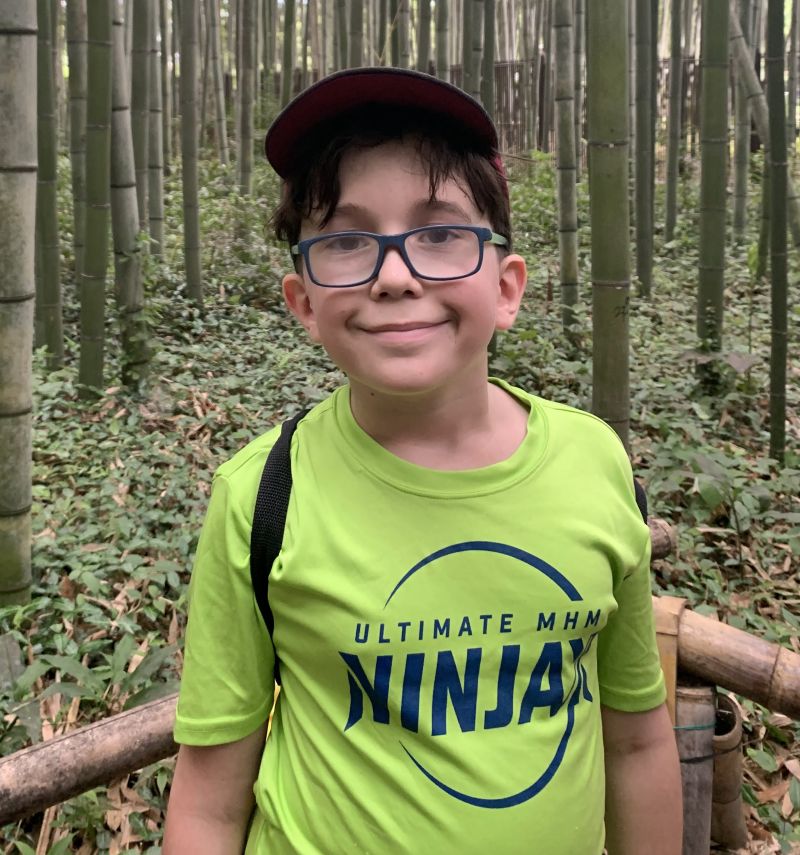
The birthday that changed everything
Ten-year-old Massimo MacFarlane is eager to tell his story. Sitting next to his mom, Amanda Ceccarelli, Massimo is animated when he speaks, showing the confidence he’s grown into through his journey.
“I was going to school,” Massimo says. “Little-dude school.”
“Daycare,” Amanda interjects.
“During daycare, I was like all the other kids,” Massimo says. “And then, COVID happened.”
Massimo turned five in 2020, the year the COVID-19 pandemic hit. He started kindergarten that fall, which is when his parents, Amanda and Dave, noticed that Massimo struggled a bit more than his peers.
“He wasn’t at the same place developmentally with his motor skills,” Amanda says. “He wasn’t progressing with things like climbing and jumping.”
The family sought medical advice, being told that Massimo must not have “played enough” when at home during the pandemic.
“There’s something more here”
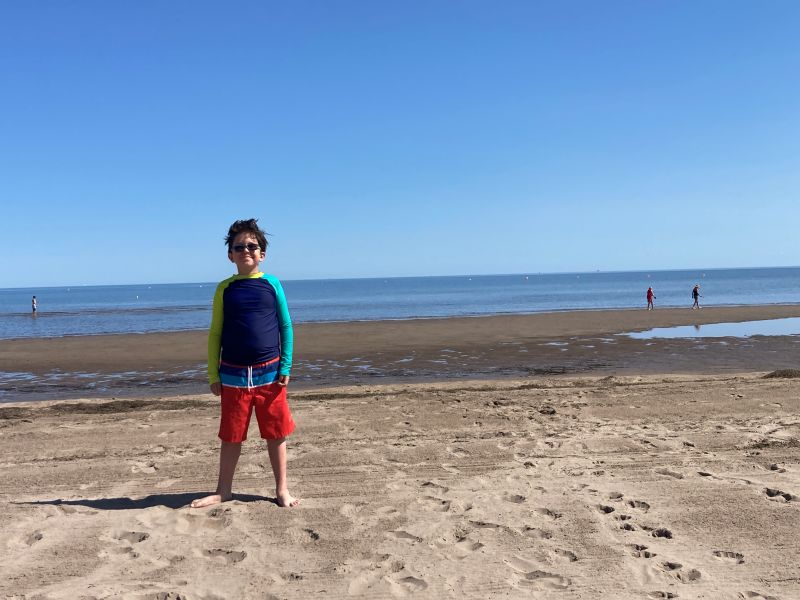 “When you’re a parent, you have that intuition that says, ‘No, there’s something more here,’” says Amanda. “But we didn’t know what it was. And we thought, he’s not sick, he’s not bleeding, there’s nothing obvious going on here. He saw a physiotherapist, he had his hearing checked. All the routine stuff.”
“When you’re a parent, you have that intuition that says, ‘No, there’s something more here,’” says Amanda. “But we didn’t know what it was. And we thought, he’s not sick, he’s not bleeding, there’s nothing obvious going on here. He saw a physiotherapist, he had his hearing checked. All the routine stuff.”
“Then, it was time for my eye appointment,” Massimo says.
It was his pediatrician who suggested Massimo get his eyes checked, thinking Massimo’s difficulties could have to do with his vision.
“The optometrist did the exam and said he noticed something, but he wasn’t sure if it was a problem or not,” Amanda says. “He didn’t feel comfortable saying everything was okay. So, he referred Massimo to an ophthalmologist, and that’s when everything sort of happened.”
The day before Massimo’s seventh birthday
It was May 17, 2021, the day before Massimo’s seventh birthday. Now in Grade 1, Massimo had trouble going up and down stairs, which Amanda says was a significant issue as most of his classes were on the second floor. Anxious for answers, Massimo’s family brought him to his ophthalmologist appointment.
“I think they didn’t want to alarm us,” Amanda says, “and so they told us, ‘Everything looks pretty good, but we’d like to make absolutely sure. Would it be okay for Massimo to have an MRI?’”
“We sat in the waiting room and the ophthalmologist came back, telling us, ‘It’s your lucky day. They have an opening for you right now,’” Amanda continues. “We know now, in retrospect, we were not lucky. We were very unlucky. They just felt it was important for Massimo to get checked out then and there, so that’s what we did.”
Massimo recalls having the MRI at the end of the day and the procedure taking longer than anticipated. When it was done, he changed out of his hospital gown and Amanda gathered their belongings from a locker.
“I took out my cell phone and saw that I had 10 missed calls,” she says. “Then, my phone started ringing. It was someone from ophthalmology, who said we couldn’t leave the hospital. They wanted us to come back to ophthalmology right away.”
That’s when Amanda learned about Massimo’s tumour.
“They explained, ‘We can’t tell you much about it, but what we can tell you is there’s so much pressure around his brain that he needs to have surgery very soon,’” Amanda says.
Adding to the shock of Massimo’s diagnosis was the timing, as the family had plans to celebrate Massimo’s birthday the next day. He was also supposed to be attending a field trip, which Amanda had volunteered to attend.
Massimo’s neurosurgeon visited the family in the hospital that evening, with his surgery scheduled for the next day.
Massimo’s surgery
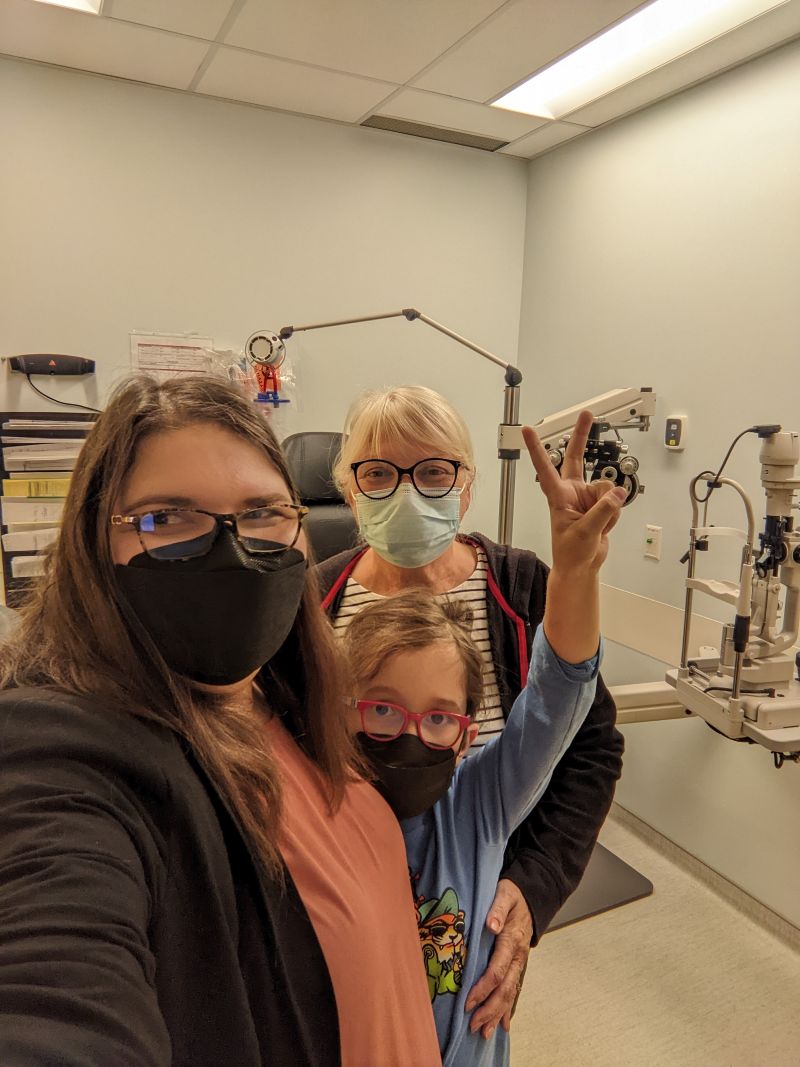 Massimo went into the pre-op area and spoke with the anaesthesiologist, who had him pick out a toy that would be waiting for him when he came out of surgery.
Massimo went into the pre-op area and spoke with the anaesthesiologist, who had him pick out a toy that would be waiting for him when he came out of surgery.
“I don’t think people necessarily understand that when hospitals do toy drives, it’s not because the people in the hospital can’t buy toys,” Amanda says. “It’s because when a kid is in the hospital or going for tests, these toys are a good distraction. They’ve been very helpful in getting Massimo through his procedures.”
Next, the anesthesiologist had Massimo pick out his favourite scent.
“‘Do you like caramel or chocolate better?’” Massimo recalls being asked. “I said, ‘Chocolate.’ And then, he put the gas mask on, and I smelled chocolate.”
“It was stressful because of where Massimo’s tumour is,” Amanda says, of Massimo’s surgery. “They wouldn’t touch the tumour because it’s wedged in next to his brainstem. They said, ‘Unless it’s growing, it’s more beneficial to wait and see.’ So, they did an ETV (endoscopic third ventriculostomy) to relieve the pressure.”
Though it wasn’t possible to biopsy Massimo’s tumour given its location, his diagnosis is thought to be a low-grade tectal plate glioma.
A hospital birthday celebration
Massimo doesn’t recall much else from that time, other than waking up to a birthday celebration he hadn’t quite expected.
“They kept asking me what day it was,” Massimo recalls. “I told them it’s my birthday, and they asked my parents if it really was my birthday.”
“We had to tell people, ‘Yes, it really is his birthday,’ because they’d look at us, like, ‘Is he completely not there?’” Amanda says.
Massimo opened his presents in the hospital and received a special video message from his classmates. They’d recorded themselves wishing Massimo a Happy Birthday from their field trip, knowing Massimo couldn’t be there but still not quite knowing what was going on.
Going back to school
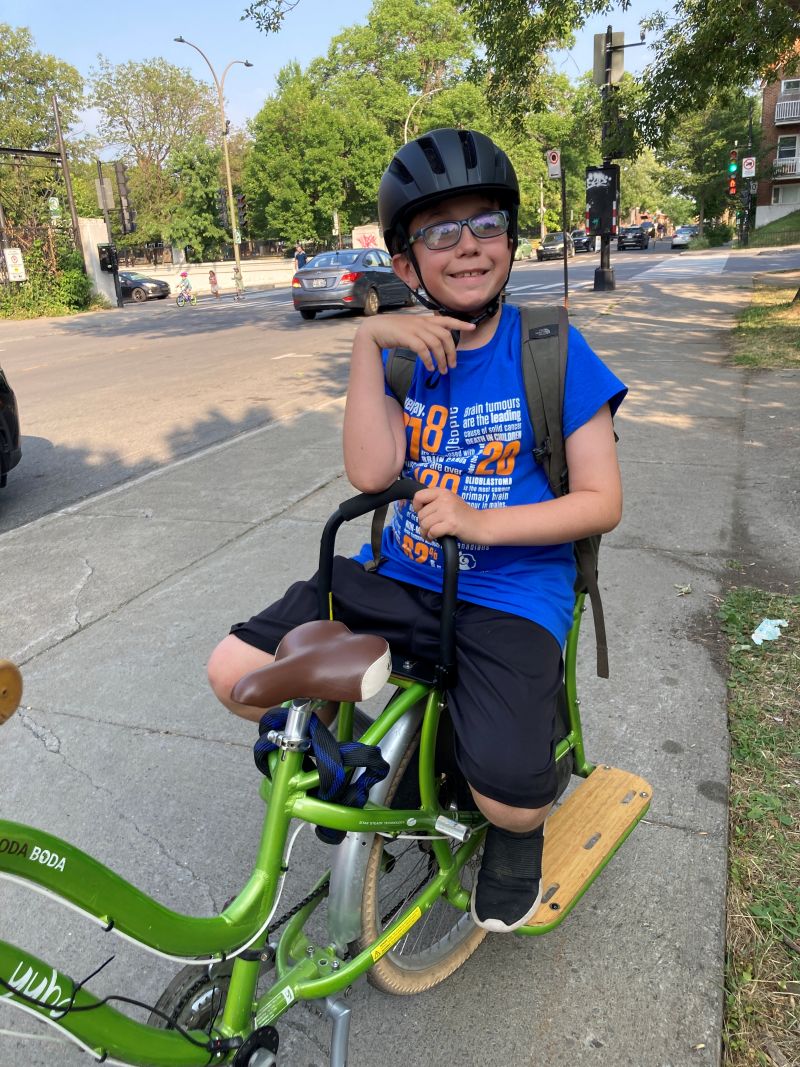 “The first day Massimo went back to school, I went into the classroom and we explained to the kids what had happened to Massimo,” Amanda says. “We let everyone see the incision on Massimo’s head and told them, ‘You don’t have to look at it, but it’s there.’”
“The first day Massimo went back to school, I went into the classroom and we explained to the kids what had happened to Massimo,” Amanda says. “We let everyone see the incision on Massimo’s head and told them, ‘You don’t have to look at it, but it’s there.’”
Massimo was paired up with older kids who would help him get up and down the stairs, so he didn’t have to manage on his own.
While he could have finished off the rest of the school year at home, Massimo looked forward to seeing his classmates and appreciated the support they gave him.
“I wanted to go back to school,” he says. “I really like going to school.”
As incredible as it was for Massimo to want to return to his ‘normal’ life, he had to adjust to the after-effects of his tumour. He’d still been experiencing pressure around his eyes, which he was given medication to control.
He started taking Diamox, or acetazolamide, alongside sodium bicarbonate, to balance the acidity in his body.
“It was not a very pleasant time in anybody’s lives,” Amanda says. “He had some side effects. He had tingly fingers, and it just made him really grumpy.”
It took nearly as long to wean Massimo off his medication as it did for him to be on it. All the while, he’d been having frequent MRIs—first, a week after his surgery, then each month after, for a year. He’d also been having monthly visits with his ophthalmologist and getting regular blood tests.
“Everything was difficult after his surgery,” Amanda says. “Going to the dentist was difficult, because he didn’t want to be there. He wouldn’t stay still during his MRI. Finally, they’d say, ‘We haven’t done all the images, but we’re done for the day.’ He was just frustrated with being sick and not ‘better.’”
Approaching things in a curious way
Massimo started taking medication to help him relax before his MRIs. Amanda would also rub his feet through the procedure, provided the technician would allow it.
“For us, it’s made a huge difference,” Amanda says. “We talk about how MRIs work and we like to joke about how they sound like funky music or robots singing. When you talk about things, they become less scary and less ‘out there.’”
“We approach things in a curious way. We’ll say, ‘What is that? How does it work?’ You can’t be afraid of something if you know what you’re dealing with.”
That mindset also applies to interactions with other people, who might not be familiar with what Massimo’s been through. At summer camp this year, for instance, Massimo would tell people he has a hard time with his handwriting, or that he struggles to balance on one leg.
“He said, ‘I can’t do that, because I have a tumour in my head and it affects my co-ordination and my balance,’” Amanda says. “That’s the way it is. We talk about it and we get it out in the open. We’ve accepted that this is part of Massimo’s life and it’s part of our lives, and that’s okay.”
That doesn’t mean it’s always been easy to deal with.
“There were a lot of breakdowns,” Amanda says. “A lot of, ‘I can’t do this,’ or ‘People don’t understand me.’”
Finding support in the struggle
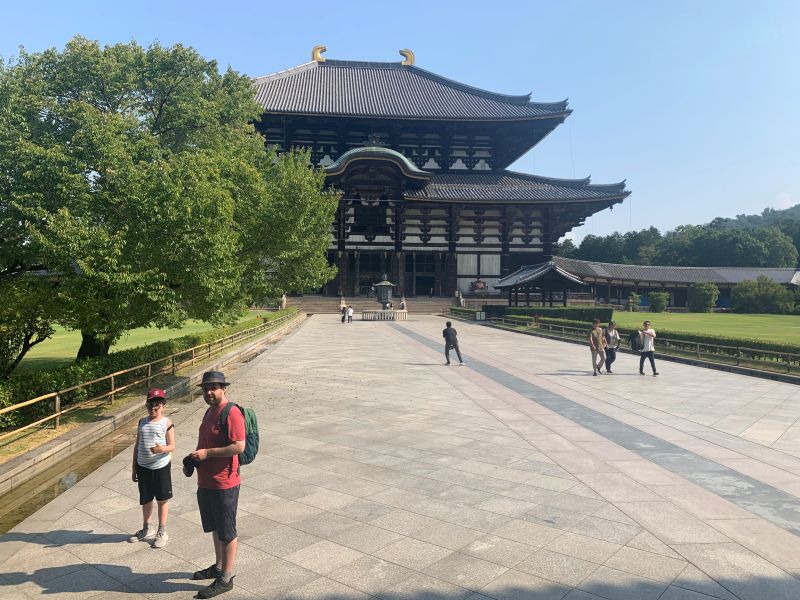 Finding the right resources has been beneficial. Massimo’s family was given a copy of Brain Tumour Foundation of Canada’s Pediatric Brain Tumour Handbooks, which helped separate fact from fiction.
Finding the right resources has been beneficial. Massimo’s family was given a copy of Brain Tumour Foundation of Canada’s Pediatric Brain Tumour Handbooks, which helped separate fact from fiction.
“The book deals with a lot of very sensitive topics in a very neutral way,” says Amanda, who received a copy from a nurse co-ordinator. “She said, ‘I’m here to give you this book because the Internet is a wild place and you probably shouldn’t be on it right now. If you have any questions, you can read this book or you can call me.’”
Massimo has found someone he trusts to talk to, and he has a supportive pediatrician who takes time to ensure he has the answers he needs.
He’s also found support in his extended family, particularly with his Nonna and Amanda’s mom, Jody Ceccarelli. A retired X-Ray technician and cancer survivor herself, Jody can relate to much of Massimo’s experience.
“She has a very special bond with Massimo,” Amanda says. “She comes to most of Massimo’s appointments with us, to be an extra set of ears and to help with the boredom of waiting.”
Massimo’s teachers and classmates have helped him ease back into school, where he’s using a laptop, and learning to type properly and how to use the different functions on a computer. He’s gone from typing two sentences to typing a full, 15-page-long story.
There’s also the understanding that Massimo gets tired more easily, so the effort he puts into writing a 15-page-long story might mean he needs a break before he moves on to the next activity.
“People don’t always see limitations if they’re not obvious,” Amanda says. “For instance, if you’re not in a wheelchair, they assume you can walk, or you just need to go to physio and you’ll be back at it.”
“People will think, ‘He’s had his surgery, so he’s recovered and he’s now 100 per cent. They want that happy-ending story, but that’s not how it works for most people with a brain tumour. For us, this is going to be forever.”
“You have to look at it as a chronic illness that you learn to live with,” Amanda continues. “You find solutions to the problems, you move forward, and you enjoy life.”
A bright future ahead
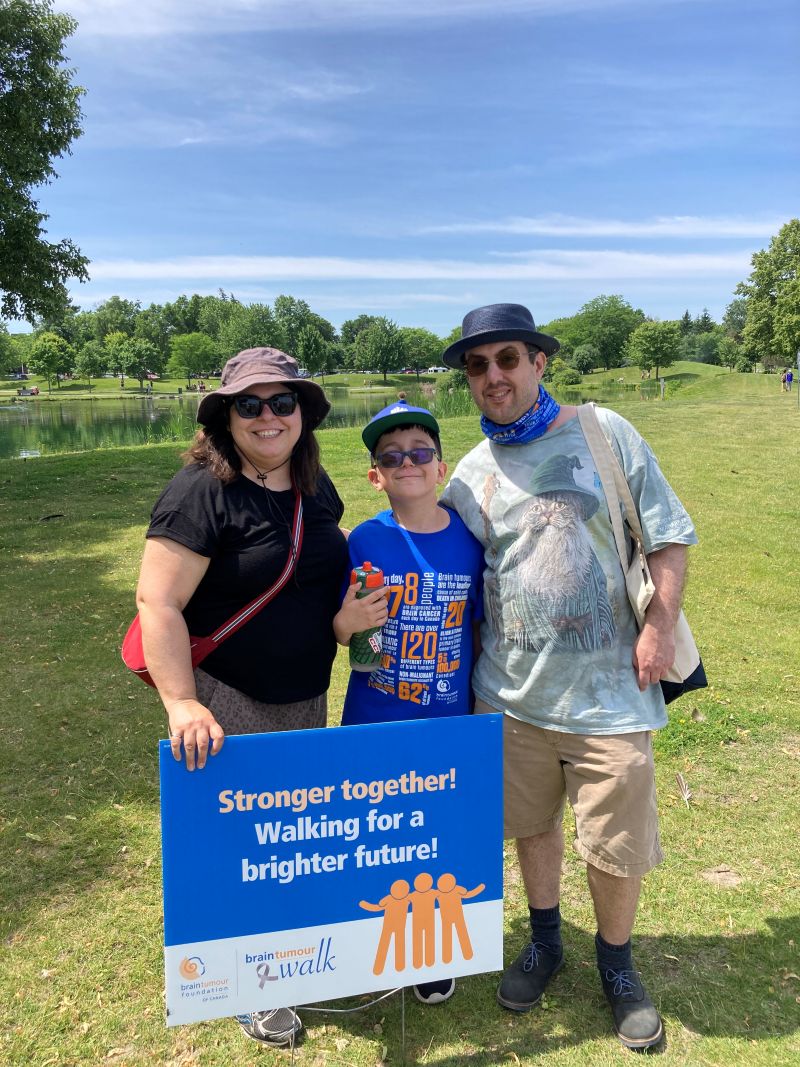 Come summer 2024, when Massimo was three years out from his surgery, he and his family travelled to Japan.
Come summer 2024, when Massimo was three years out from his surgery, he and his family travelled to Japan.
“We’d talked about going for a long time,” Amanda says, “and then COVID happened, and then Massimo wasn’t well.”
“Some people were like, ‘Is being on an airplane for 10 hours going to be okay?’” Massimo says. “Meanwhile, my doctor told us to go, and I loved being on an airplane for 10 hours. I got to play Angry Birds!”
“We’re very big on enjoying the things we want to do,” adds Amanda.
They’ve participated in Brain Tumour Walks, first in their hometown of Montreal in 2023, and then in Ottawa in 2025.
“We felt it was really important for Massimo to see that he’s not alone,” says Amanda. “When he looks around and sees other people with blue survivor shirts on, he thinks, ‘Hey, wait a second. They went through something like I did.’”
Massimo connected with Ben Seewald, support services specialist at Brain Tumour Foundation of Canada and a brain tumour survivor himself, at this year’s Ottawa Brain Tumour Walk.
“Talking with Ben was really nice, because Massimo realized, ‘Maybe one day, I could have a job like Ben does,’” Amanda says.
For now, Massimo hasn’t discounted being a YouTuber or an UberEats driver. He’d also like to work at Expedition Jeux, a local store that sells gaming cards.
He keeps up with his regular check-ups and MRIs, which are nine months apart now, while looking ahead to the future.
Whatever path Massimo takes, whether it’s behind a camera, a wheel, or a shop counter, or helping others on their own brain tumour journeys—it’s clear he’ll approach it with the same curiosity and courage that has carried him this far.